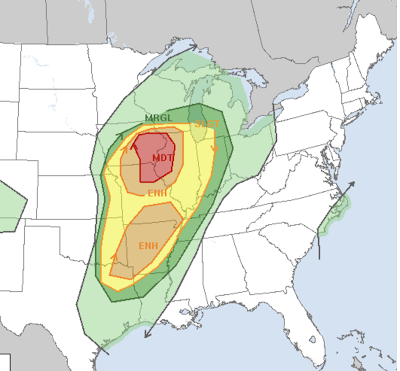I should not have been so smug.
At last check, 32 people died in the Friday tornadoes, which is worse than the death toll from twisters exactly a week earlier. This toll includes another person died in a Delaware tornado on Saturday.
The deaths back on March 24 were focused on Mississippi, where dangerous night time tornadoes blasted a handful of relatively rural towns.
I think so many people died March 24 at least in part because the tornadoes came through at night, when people aren't as aware of the danger.
Not only was the death count worse than a week early, this past Friday's tornadoes covered a far, far more widespread area.
By my count, more than 100 preliminary reports of tornadoes came in from at least a dozen states. It was one of the most widespread outbreaks I've seen in recent years. It stretched from Arkansas to Georgia and from Iowa to New Jersey and Delaware.
This time, the death toll was high because there were so many tornadoes. With that many twisters - some of them unusually violent - spinning in so many different places, it's inevitable there would be casualties no matter how good the warnings.
As the Associated Press reports, the most concentrated deaths were east of Memphis where nine people died in yes, a tornado that struck after dark. Overall in Tennessee, 15 people died in this outbreak, so Tennessee was the worst hit in this one.
So far this year, 63 Americans have died in tornadoes. The average annual number of deaths from twisters is 80, so we're already pretty close. The absolute peak of tornado season doesn't hit until late April through early June, so we've got a long way to go.
A new, thankfully lesser and smaller severe storm outbreak hit northern Texas Sunday. I'm not yet sure if any tornadoes touched down, but there were several reports of damaging winds and large hail. Airports around Dallas declared ground stops as the storms rolled through. I'm also not aware of any deaths or serious injuries in Texas last night.
NEXT UP.
Now, unfortunately, it's rinse and repeat. A storm that appears as if it will be remarkably similar to Friday's is looming for the Midwest and South tomorrow. Forecast maps show the exact same areas that were under the highest risk Friday are again at the greatest peril from this new storm.
The strongest tornadoes at this point seem poised to hit eastern Iowa, western Illinois and northeastern Missouri which were hit hard last Friday.
Arkansas looks like another target. This after neighborhoods on the west and north side of Little Rock were devastated by a large tornado on Friday.
In Arkansas, one person died in North Little Rock. About 50 people in the Little Rock metro area were injured and the city said 2, 648 structures were damaged or destroyed. The supercell that produced the Little Rock tornado dropped another twister on the city of Wynne, Arkansas, causing an additional four fatalities.
I'm sure people in Arkansas are praying there won't be a repeat.
Much like on Saturday, this storm could produce severe weather in Ohio, Pennsylvania and western New York on Wednesday,
This same storm system is also going to create another blizzard in the northern Plains.
One glimmer of hope is that after this next storm, things are forecast to settle down for awhile. The weather pattern is changing, at least temporarily, to one that will produce little severe weather and a rather low chance of tornadoes in the U.S. for at least a week, beginning Thursday.
This was kind of a morbid post, but sometimes reality sucks. Maybe tornado season is getting is energy out early and the rest of it will be more mild? Time will tell.


No comments:
Post a Comment